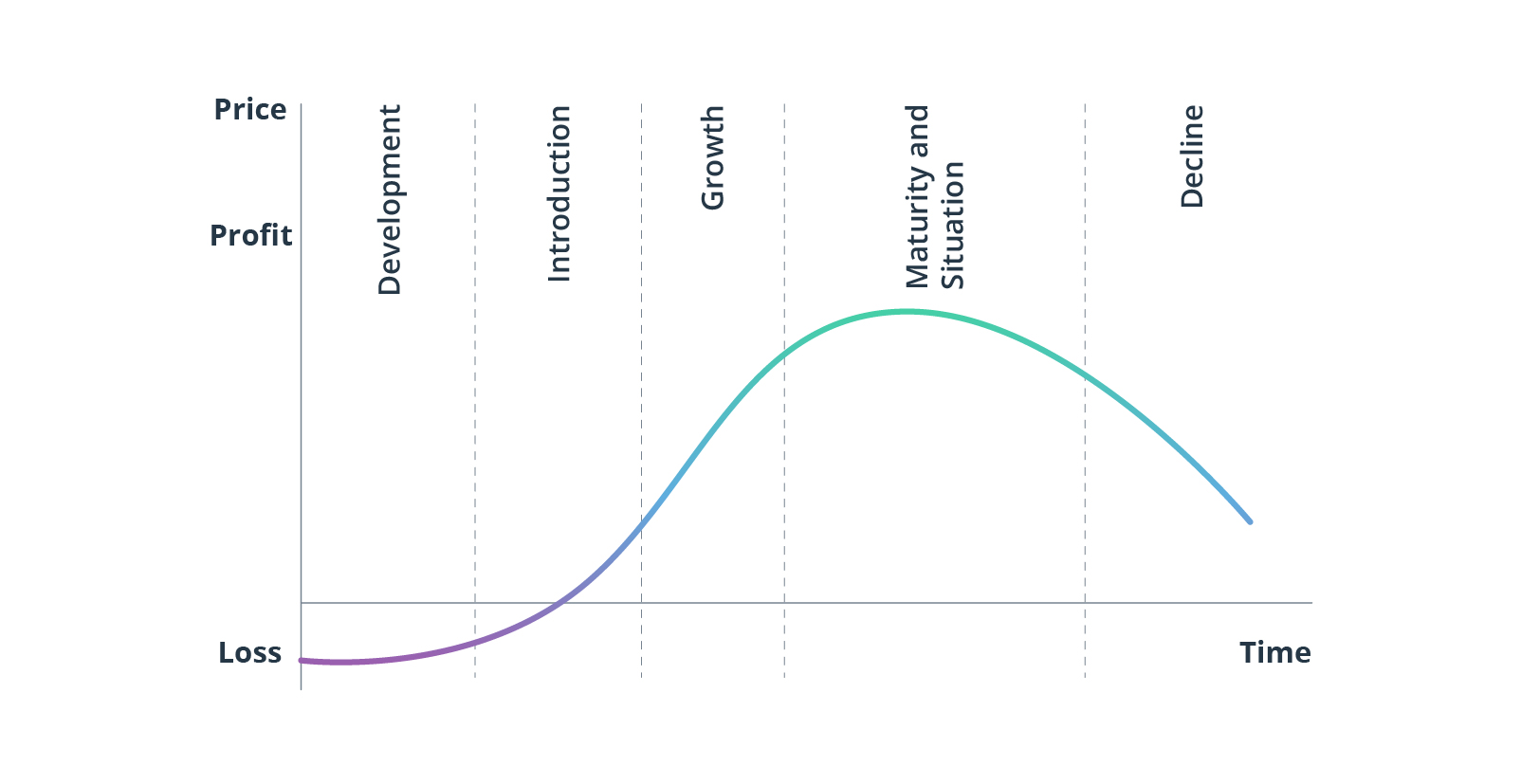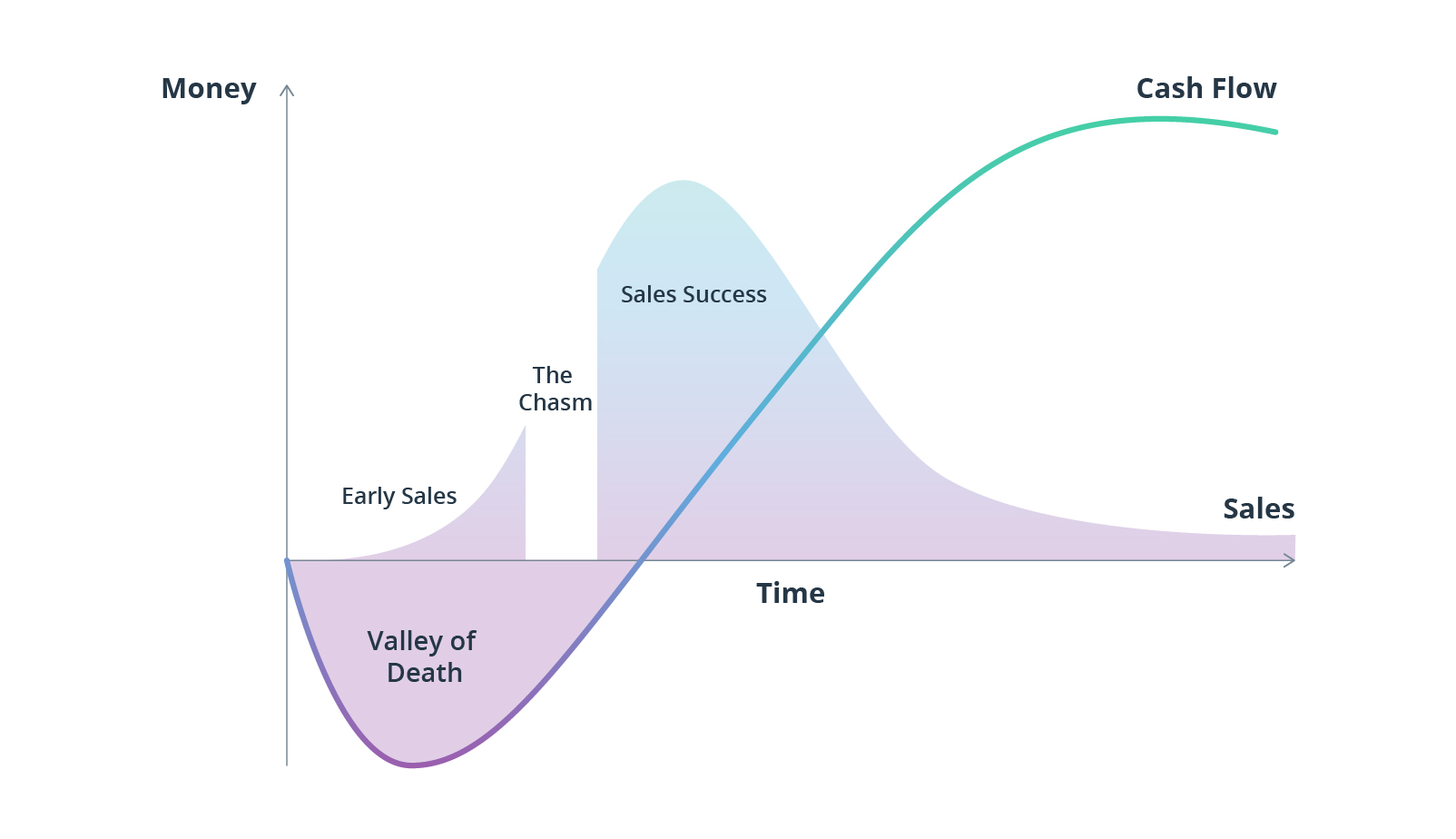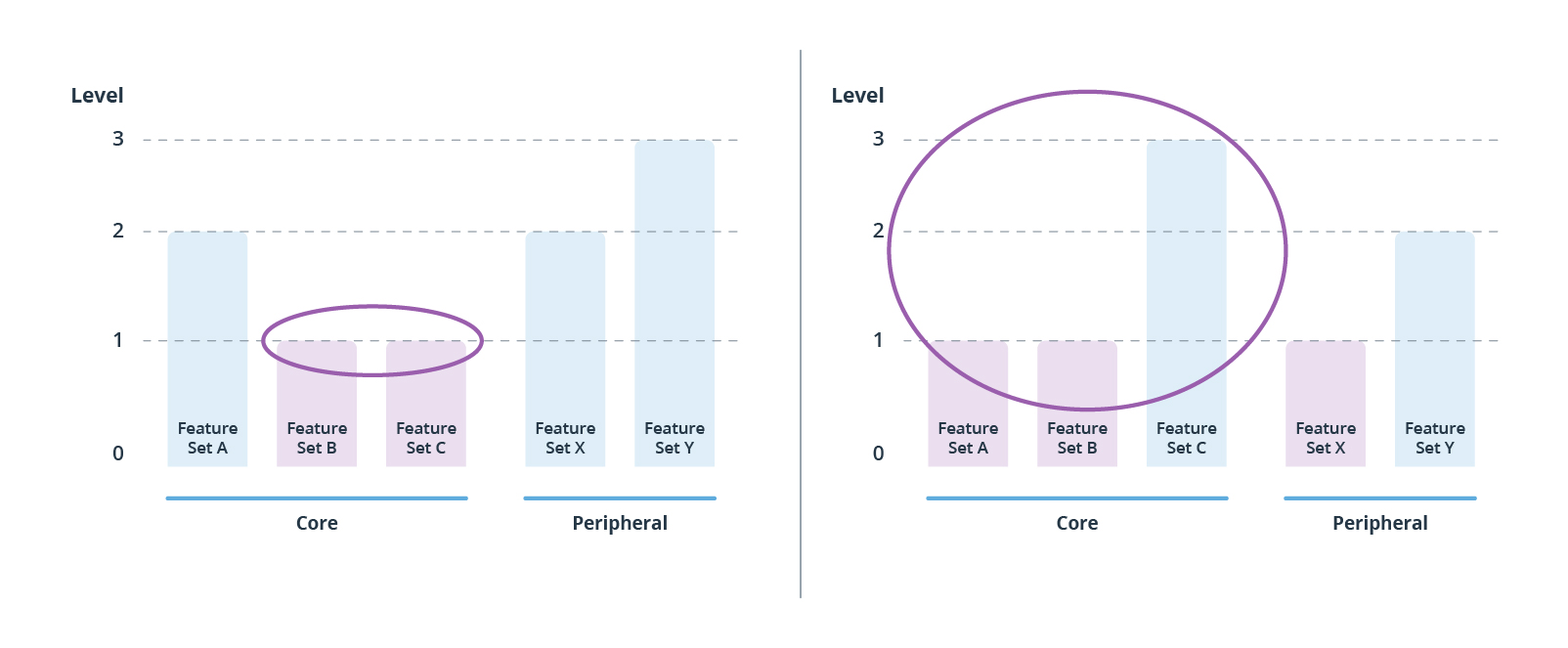Fundamentally, an MVP in product development is the first product release with just enough features to validate a set of hypotheses — your assumptions about your target market and customers.
The minimum viable product is that version of a new product which allows a team to collect the maximum amount of validated learning about customers with the least effort.
But what happens after the first successful release? How did companies like Dropbox and Instagram (both adopters of the MVP approach to product development) scale into the enterprises we know today?
That’s the idea we want to explore in this post — scaling an MVP into a mature product.
You’ve launched an MVP: What’s next?
Stories of the MVP approach to product development often sound like a fairytale. After an epic adventure, we arrive at the happy ending — the big launch day. Everyone’s cheering, bottles are popping, and the team toasts to “happily ever after.”
But what is actually hiding behind the happily ever after is more hard work.
Launching an MVP isn’t the end of the journey. It’s just the first stop in your product development lifecycle. So what does an MVP mean in product development?
Product development lifecycle

Source: O’Reilly
After introducing an MVP, you need to prove its viability — its commercial potential in terms of finding sufficient market demand, sustaining customer interest, and having customers who are ready to pay the set price.
Not everyone makes it through this growth stage. Only 1% of startups become unicorns, while 90% fail for an array of reasons: no market need, high competition, flawed business model, regulatory challenges, pricing/cost issues, poor product design.
Most innovative products don’t generate immediate profit, and those that do often get by on slim margins. Instead of heading into the maturity phase, they end up in the death valley curve — a period of declining sales, cash flow, and marketing ROI.

Source: Semantic Scholar
At this point, product teams often face confusion and tough choices. Common questions flying around are:
- What capabilities should we add to increase revenue?
- What technical debt issues should we tackle to optimize costs?
- In what sequence should we deliver new features?
- How can we scale this product to address a bigger target market?
What you’re probably trying to figure out at this stage is whether you should move forward with investing in further product development or shelve your idea before it gets even more expensive.
Surviving the valley of death: Scaling vs pivoting
Let’s start with the worst-case scenario: your new product seems to be flopping. The sales figures are below your projections, and the user base isn’t growing as fast as you hoped.
This can signal a genuine miscalculation on your part or a poor choice of metrics for your product engineering strategy — in other words, you could be looking at the wrong numbers to evaluate your success.
But if you have miscalculated and your initial hypothesis has been disproved, you can do the next best thing — pivot. Take it from Instagram, which originally launched as a Foursquare competitor under the name of Brbn. Brbn launched with a handful of location-based features for check-in, friend meetups, and photo sharing. But users weren’t loving it. Most found the app’s check-in flow too complicated.
Users, however, were obsessed with the photo sharing features, so the team pivoted and saw great success.
That said, pivoting from a poor product idea is hard, especially when you’re saddled with loss aversion — a bias that makes the pain of losing psychologically twice as powerful as the pleasure of gaining. Kodak once held 90% of the film and 85% of the camera sales markets in the United States. But then digital cameras came along and the company’s core business went bust.
Didn’t Kodak see digital coming? It did. In fact, the world’s first digital camera was invented in 1975 by Steven Sasson — a Kodak engineer. As Sasson recounted in a New York Times interview, Kodak management knew that digital cameras would chop away market share, but they chose to continue making money from film (while it lasted) instead of investing in new product development. This decision led to Kodak’s demise.
Many businesses choose the safer path of marginally improving existing products instead of venturing into high-risk and high-reward territory — when they should be doing the opposite.
Ken Norton calls this “the 10X, not 10%” growth framework:
“To become a new disruptive force on the market, companies need to aim for a 10X moonshot scale of product development, instead of focusing on marginal 10% product improvements with each interaction.
Does such bold thinking increase the chances of failure? Of course. But it also wildly increases the growth prospects. As Alphabet CEO Larry Page once said: “It’s natural for people to want to work on things that they know aren’t going to fail. However, incremental improvement is guaranteed to be obsolete over time. Especially in technology, where you know there’s going to be non-incremental change.”
Let’s say you took risks and your new product is getting traction. Positive customer feedback is coming. Tracked product metrics are in the green and your marketing is bringing more customers.
You have people’s attention (and money), but you’re also pressed to deliver on growing expectations.
Here’s when the challenges of scaling an MVP kick in. You will need to figure out how to:
- Orchestrate further product growth
- Effectively scale operations
- Engineer new feature releases fast
- Avoid accumulating massive technical debt
- Address compliance and security issues
- Keep customer acquisition cost (CAC) at bay and get profitable
- Maintain a lean budget (while you raise funds)
In short: You need to establish product engineering process and do so at speed and at an optimal cost.
How to scale an MVP: Best practices
As any avid gardener knows, a sapling takes a long time to turn into a fruit-bearing tree. The same goes for an MVP — a lot of grooming, pruning, and nurturing is required to become profitable.
As a technology partner, Intellias has seen cases of both successful and side-tracked digital product scaling. And we know that failure can come from many angles — from subpar architectural choices to poor security processes or a lopsided feature maturation strategy.
For streamlined growth, our consultants recommend implementing the following essential practices.
Set and analyze the right product metrics
Jim Barksdale, the former CEO of Netscape, once said:
If you have facts, present them and we’ll use them. But if you have opinions, we’re gonna use mine.
Your product development efforts should be driven by data, not hunches. Rather than just following through with a good idea, you should test and prove or disprove each assumption.
For that, you need north star metrics — top-line data points that measure your ability to solve the customers’ core problems while driving long-term business goals around growth and profitability.
A north star metric is something you refer to at the end of each argument. Will shipping feature A first improve the north star? If yes, proceed. If not, ditch it.
Many startups begin with one north star metric at the early growth stage to maintain a laser-sharp focus and apply targeted efforts. For example, Airbnb relied on nights booked to increase the total number of transactions on the platform and thereby ignite consumption growth (and transactional revenue).
Twitter focused on the number of daily active users (DAU). Since its monetization strategy was concentrated on traffic, Twitter needed to maintain high engagement numbers to keep growing its revenue.
Lenny Rachitsky, an author and former product lead at Airbnb, published a brilliant breakdown of north star metrics popular startups have used at the early growth stage.
In general, north star metrics can be grouped into six categories:
| Revenue | Customer growth | Consumption growth |
|---|---|---|
| Annual recurring revenue (ARR) | Number of paid users | Transaction volume |
| Gross merchandise volume (GMV) | Conversion rates (trial-to-paid, demo-to-sale, etc.). | Adoption rates |
| Engagement growth | Growth efficiency | User experience |
| Daily active users (DAU) | Customer lifetime value (CLV) | User retention rates |
| Monthly active users (MAU) | Customer acquisition costs (CAC) | Net promoter score (NPS) |
At the product growth stage, you must set up and track selected north star metrics to ensure that your product development goes in lockstep with them.
Your goal is to understand which product features drive positive returns. Then decide how you can make these features 10 times better to drive further traction, and prioritize them for development.
Analyze the backlog
Analyzing product metrics also helps you identify new segments of opportunity — areas where you can improve or add to your product to meet more users’ needs.
For example, if 80% of users rate smooth checkout as an extremely important feature but only 30% are satisfied with the current checkout experience, this is a good area for improvement. On the other hand, if only 20% say that a web app is important to them while 85% are satisfied with the mobile product version, developing a mobile web app can wait.
For example, when working with a biotech client on a new set of digital products for agriculture, our BA analysis and user research found that it was worth rolling out two product lines instead of one as originally planned because doing so would allow the client to capture additional high-value customer segments.
There are different ways to capture and quantify user sentiment: via surveys, UX studies, product analytics, or even public feature upvoting. Afterwards, you can apply different frameworks for prioritizing features such as the Kano model, value vs. effort matrix, or weighted score model to shape your product backlog.
Balance the trade-offs of new feature development
At the growth stage, many teams want to prioritize creating customer-facing features. That’s a no-brainer, as they provide more levers for improving tracked metrics. The problem, however, is that chasing customer expectations can throw you off your balance.
The average customer considers between 50 and 150 metrics (their desired outcomes) when assessing how well a product or service enables them to execute any job. Few products can immediately meet all those expectations. So you’ll have to prioritize.
An over-zealous focus on the product’s front end can lead to performance issues in the back. If a shiny new feature is lagging because of poor architectural choices, you’re in trouble. Likewise, poor operational and support workflows will silently undermine the customer experience (CX) and create bottlenecks for your teams, resulting in low efficiency and a prolonged time to market.
Our best advice when prioritizing a product backlog: Always consider the tradeoffs of releasing new features vs accumulating technical debt.
In some cases, it’s better to concentrate your efforts on improving your basic infrastructure instead of adding more features on top.
Airbnb, for example, was originally designed as a monolithic platform on Ruby on Rails, nicknamed Monorail. For the early stage, this architectural pattern did the job. But as the company’s user base and engineering workforce grew, Monorail became a major nuisance.
As our engineering team continued to grow, so did the spaghetti entanglement over Monorail code. It became harder to debug, navigate, and deploy Monorail, and it became a source of engineers’ frustration.
As the team continued adding new features to Monorail, a single database was no longer coping with the load. The team also couldn’t commit new code at the speed they wanted to because the platform was blocked.
To remove this bottleneck, Airbnb took the bold step of migrating from a monolithic to a service-oriented architecture (SOA) (and eventually a fully decoupled microservices-based architecture).
By choosing to focus on transforming the backend architecture, Airbnb majorly improved its speed of delivering new product features without any operational disruptions. According to Tai, post-migration Airbnb went from doing 3,000 code deployments a week with 800 engineers to 10,000 deployments a week with 1,000 engineers, which equals one deployment every minute.
Develop a feature maturation strategy
Minimum viable products include essential features designed to validate product–market-fit and gauge the demand.
During the growth stage, your goal is to double down on evolving the most liked, used, and revenue-generating features.
Kotler’s Five Product Levels can help you determine the optimal direction for product maturation efforts.

Source: Praxie
Source: Mind the Product
What is an MVP in product development according to Kotler? An MVP sits at the lowest product levels (Core and Generic). It satisfies customers’ essential needs and has only features that are absolutely necessary for the product to function.
An expected product, in turn, meets a wider range of customer expectations, in line with similar products.
Augmented products focus on differentiation from the competition, offering benefits and features to satisfy more demands.
Finally, a potential product includes all transformations and add-ons that the product may undergo in the future to meet an even wider spectrum of consumers’ needs and wants.
A feature maturation strategy should be concentrated on core product features since they represent the product’s main value proposition. Secondary features can often make do with basic functionality to avoid value prop dilution.
That said, teams often get side-tracked and focus on maturing secondary features instead of building out core features. Likewise, core features can vary in terms of their maturity.
Feature maturation anti-patterns

Source: Mind the Product
Opportunity scoring is the best way to understand if you’ve selected the optimal feature maturation approach.
Opportunity scoring is a type of gap analysis that helps identify which features customers find important but underdeveloped. In essence, you ask customers to rate the importance of and their satisfaction with several product features.
This feature prioritization framework is based on the outcome-driven innovation (ODI) method created by Tony Ulwick. Ulwick noticed that customers often can’t articulate what they want in terms of a specific feature, but they can explain what outcome they want to achieve. ODI and opportunity scoring help companies learn more about customers’ goals and align product development accordingly.
You can collect this type of feedback via private surveys and interviews, or get it from a public product roadmap. For instance, Monzo heavily relied on a public product roadmap (and user forums) during its early growth stage to gauge customers’ perception of their product and identify the next most promising features. Using public feedback, Monzo prioritized savings pots, travel reports, and an Android app, as these were the most requested features by the community.
Similarly, in-depth solution discovery can be applied to mature products that are overdue for modernization. That was the case with one of our clients, a licensed trucking mileage software provider whose product was used by 75% of IFTA agencies and 94% of the top motor carriers, brokerages, and manufacturers across North America.
The company wanted to evolve its products to meet the demands of new digital mobility models and industrial consumerism. Our team conducted an in-depth analysis of the client’s product portfolio and proposed a new product vision based on users’ needs and emerging market opportunities.
Based on the product portfolio assessment, we formulated a new plan for software modernization and an MVP-like prototype, detailing a new product roadmap, solution architecture, potential technology trade-offs, and viability assessments.
Intellias provided a clear development roadmap for the client’s mileage and routing system, with an implementation plan for new value-added features that meet current market requirements, level up the customer experience, and optimize the path to profitability.
Implement CI/CD and CE
Figuring out which features to build is only part of the scaling equation. You also need to upgrade your software development process.
Here’s a common scenario when a company begins to scale an MVP:
- You hire more software developers, but new developers struggle to understand your code base and architectural principles.
- The number of bugs, glitches, and other product performance issues increases and affects the customer experience due to poor test coverage.
- A shared codebase and inability to do work in parallel creates further bottlenecks. Different development teams disrupt each other’s work, new code deployments take ages, and the team’s velocity decreases despite the increased headcount.
Sound familiar? Then it’s time to implement CI/CD pipelines.
Sample CI/CD pipeline

Continuous integration and continuous delivery are the two essential processes for shipping new features faster.
Continuous integration means that all code changes from multiple developers are frequently integrated into a single software project. All code from the central repository goes through automated tests and other reviews (checking for quality, syntax style, etc.) before being packaged as a new build. This helps detect and prevent problems in software early on.
Continuous integration enables continuous delivery — the practice of automatically keeping code in a deploy-ready state. Continuous development pushes the build to a production-like environment, where it can be further tested and set for manual or automated release (continuous deployment).
CI/CD helps establish repeatable, reliable processes for shipping new software. Different teams can work independently but adhere to the same quality requirements and standards codified in the CI/CD pipeline.
With CI/CD, product engineers can achieve:
- Faster velocity
- Higher code quality
- Targeted fault isolation
- Greater test coverage
- Faster release rate
By relying on CI/CD and Agile project management practices, our team delivered an MVP mortgage platform in just one month and a solution with advanced features in another six. Within two years, the new mortgage platform started generating almost 10% of the company’s annual revenue.
Product-centric teams also enhance their CD pipeline with a continuous exploration (CE) stage.

Source: Scaled Agile
Broadly speaking, continuous exploration is an Agile method of generating a steady flow of new product ideas, styled as user stories. User stories are small backlog items that can rapidly traverse through the CD pipeline.
Continuous exploration doesn’t have to be a lengthy stage in which the team writes out every edge case, mocks up each solution, and gets tech leads to determine the exact product timelines.
Take a cue from Dropbox, which created a simple yet effective process for sourcing and shipping new product features. The engineering team uses a three-phase approach to proposing and releasing new product ideas:
- Phase 0 — Anyone can submit a one-page template, explaining a problem and why it’s worth solving.
- Phase 1 — All approved ideas land in front of the Dropbox product manager, who’ll do a more in-depth product review, get the technical specifications, and design mockups.
- Phase 2 – A more traditional product review session, designed to lock in all the details and formalize the requirements for development.
Such an approach allows Dropbox to obtain great ideas from every level of the organization, test multiple hypotheses, and move forward with the most viable product ideas.
Direct effort towards ancillary processes
To reach the maturity stage, you’ll also need to sort out your ancillary processes — everything from customer support and operations to cybersecurity and infrastructure monitoring.
During earlier stages of product development, these processes are often treated as an afterthought since they don’t directly affect the north star metric. But ignoring them completely can cause issues down the road.
Take Zoom, for example. Its business user base grew by 470.33% in 2020, but security concerns came as the flip side of popularity (Zoombombing, routing calls through China).
Instead of shipping new features, Zoom had to focus on ancillary processes. In April 2020, Zoom CEO Eric Yuan announced a 90-day freeze on new feature development and shifted most of the company’s engineering effort to fixing security and privacy. The team introduced two-factor authentication, added default meeting passcodes, and introduced virtual waiting rooms, among other features.
Surely, this was done at the expense of new feature development, but by further ignoring security, Zoom would have risked its newly acquired market share.
At the growth stage, companies are thinking more about architecture design and technical debt.
As the number of concurrent users increases, earlier issues with poor database design or platform scalability become apparent — and they should be addressed before more features get slapped atop an already shaky structure.
Technical debt should be repaid in installments, as with financial debt. Include debt-related items into new sprints, alongside backlog features, change requests, and other tasks to continuously tackle the debt.
Intellias has helped a FinTech lending company successfully tackle technical debt while shipping new features. In one and a half years, we’ve fully refactored the company’s core platform from monolithic to microservices while maintaining all system operations throughout the whole process and achieving the ROI cycle in one year.
To avoid major sacrifices in new feature development, we established a well-balanced allocation of rework tasks per sprint (from 25% to 10%) and introduced a daily release cycle with CI/CD and QA process automation. This way, the company could continue to delight users with new ROI-generating features while improving backend operations.
Final Thoughts
Developing a new product is a high-risk but high-reward process. An effective MVP product development process and its scaling is focused on maximizing the gains and minimizing the dangers of potential mishaps, which can happen at any level — market fit, technology, business model, or even execution.
Soundly, product development is no longer a guessing game. With the right frameworks and processes, you can confidently ship new product features that bring growth across key business metrics to take your product to the maturity stage.
Intellias helps global businesses get on the right track with product development consulting. We can recommend how emerging technology best fits into your product strategy and explain how to develop a minimum viable product, set up lean product engineering processes, and deliver competitive products fast. Contact us.


